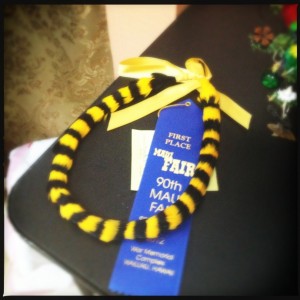Maui Lei Artist Teaches Hands-on History (MauiNow.com)
 Within a few days, most leis have withered into something rather sad-looking.
Within a few days, most leis have withered into something rather sad-looking.
Not so with the feather-based creations done by Pattie Hanna and her students.
Those students took home nearly a dozen blue ribbons at the 90th annual Maui county fair, it is clear Hanna’s goal is coming to fruition. “What matters to me as a lei maker is passing it on; who came before me and after me is what’s most important.”
Hanna is fifth generation from the Keokea feather lei maker line, although specifics become more and more vague as one goes backwards in the lineage, usually ending with “some lady or guy up in Kula.”
At one time, only Hawaiian royalty were allowed to wear feathers.
However as hula and Hawaiian language was discouraged, the symbolic feather art continued quietly in the countryside and the knowledge survived. Royal lei were banned, but the lei makers adapted the knowledge to other applications. Whether these paniolo (cowboy) artists were intentionally rejecting the new rules or continuing their heritage despite the laws is unknown.
Hanna learned by observing the lei makers there in Keokea where she grew up. “I was taught in the Nana i ka kumustyle which is to watch quietly, listen attentively and keep your mouth shut.”
Once upon a time, the royal birds used for lei were trapped by the members of a male-only guild called po’e hahai manu. One or two feathers was taken from each of the birds – most of which were as small as cardinals and are now extinct – and the bird was then released. The ‘i‘iwi and ‘apapane birds were used for red, ‘o‘o for pale yellow, and mamo for a rich gold color.






